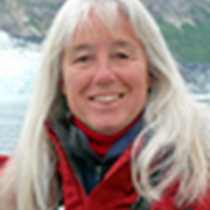Cascade Creek, Petersburg
The National Geographic Sea Bird entered Thomas Bay this morning with blue skies above and a small rainbow to the north. We passed by the Baird Glacier and entered Scenery Cove for views and reflections of the grandiose, glacier-carved landscape before breakfast. Arctic terns were busy shuttling their daily catch to their gravelly nests on the glacial moraine. Joyful birdsong came from the bubbly winter wren in the nearby forest. Marbled murrelets had already left their nests in ancient trees to dive for small fish to feed themselves and their nestlings. Both forest and ocean ecosystems must be protected for these species to survive.
We anchored for our morning activities, which included kayaking and hiking. The kayakers had good views of colorful harlequin ducks. Some paddled their small crafts right up to the torrential mouth of Cascade Creek.
The hikers were introduced to the components of the temperate rainforest as they walked to a waterfall on a U.S. Forest Service trail. Some people continued up a set of steep steps to an upper bench and a bridge across a roaring creek. On the other side we searched for one of six native amphibian species found in Alaska – the rough skinned newt. This toxic little salamander’s only known predator is the garter snake. Since there are few garter snakes in Southeast Alaska, it is unknown why the newt remains so toxic in an area where it may have no predators.
Petersburg is a pleasant and friendly working fishing village on Mitkof Island with a Norwegian flavor and heritage. We had many choices for activities here. Some guests took spectacular flights over glaciers for a perspective that showed them a bigger picture of the region. In town, there was time to stroll along the main street or ride bikes beyond the downtown area. Eagle’s Roost Park is a great place to see and photograph both adult and immature bald eagles. Ravens are also abundant in the area.
Across the channel on Kupreanof Island there is a boardwalk trail through a muskeg (peat bog). About twenty percent of Southeast Alaska is muskeg, interspersed between forest stands. It is characterized by sphagnum moss (peat), stunted shore pines, plants in the heath family and standing pools of water (poor drainage). Acidic conditions inhibit bacterial action causing partially decomposed vegetation to build upon itself. Carnivorous plants called sundews derive nutrients from insects they snag on sticky tentacles.
It was a varied, active, and fulfilling day and we look forward to the adventures of tomorrow.
The National Geographic Sea Bird entered Thomas Bay this morning with blue skies above and a small rainbow to the north. We passed by the Baird Glacier and entered Scenery Cove for views and reflections of the grandiose, glacier-carved landscape before breakfast. Arctic terns were busy shuttling their daily catch to their gravelly nests on the glacial moraine. Joyful birdsong came from the bubbly winter wren in the nearby forest. Marbled murrelets had already left their nests in ancient trees to dive for small fish to feed themselves and their nestlings. Both forest and ocean ecosystems must be protected for these species to survive.
We anchored for our morning activities, which included kayaking and hiking. The kayakers had good views of colorful harlequin ducks. Some paddled their small crafts right up to the torrential mouth of Cascade Creek.
The hikers were introduced to the components of the temperate rainforest as they walked to a waterfall on a U.S. Forest Service trail. Some people continued up a set of steep steps to an upper bench and a bridge across a roaring creek. On the other side we searched for one of six native amphibian species found in Alaska – the rough skinned newt. This toxic little salamander’s only known predator is the garter snake. Since there are few garter snakes in Southeast Alaska, it is unknown why the newt remains so toxic in an area where it may have no predators.
Petersburg is a pleasant and friendly working fishing village on Mitkof Island with a Norwegian flavor and heritage. We had many choices for activities here. Some guests took spectacular flights over glaciers for a perspective that showed them a bigger picture of the region. In town, there was time to stroll along the main street or ride bikes beyond the downtown area. Eagle’s Roost Park is a great place to see and photograph both adult and immature bald eagles. Ravens are also abundant in the area.
Across the channel on Kupreanof Island there is a boardwalk trail through a muskeg (peat bog). About twenty percent of Southeast Alaska is muskeg, interspersed between forest stands. It is characterized by sphagnum moss (peat), stunted shore pines, plants in the heath family and standing pools of water (poor drainage). Acidic conditions inhibit bacterial action causing partially decomposed vegetation to build upon itself. Carnivorous plants called sundews derive nutrients from insects they snag on sticky tentacles.
It was a varied, active, and fulfilling day and we look forward to the adventures of tomorrow.



